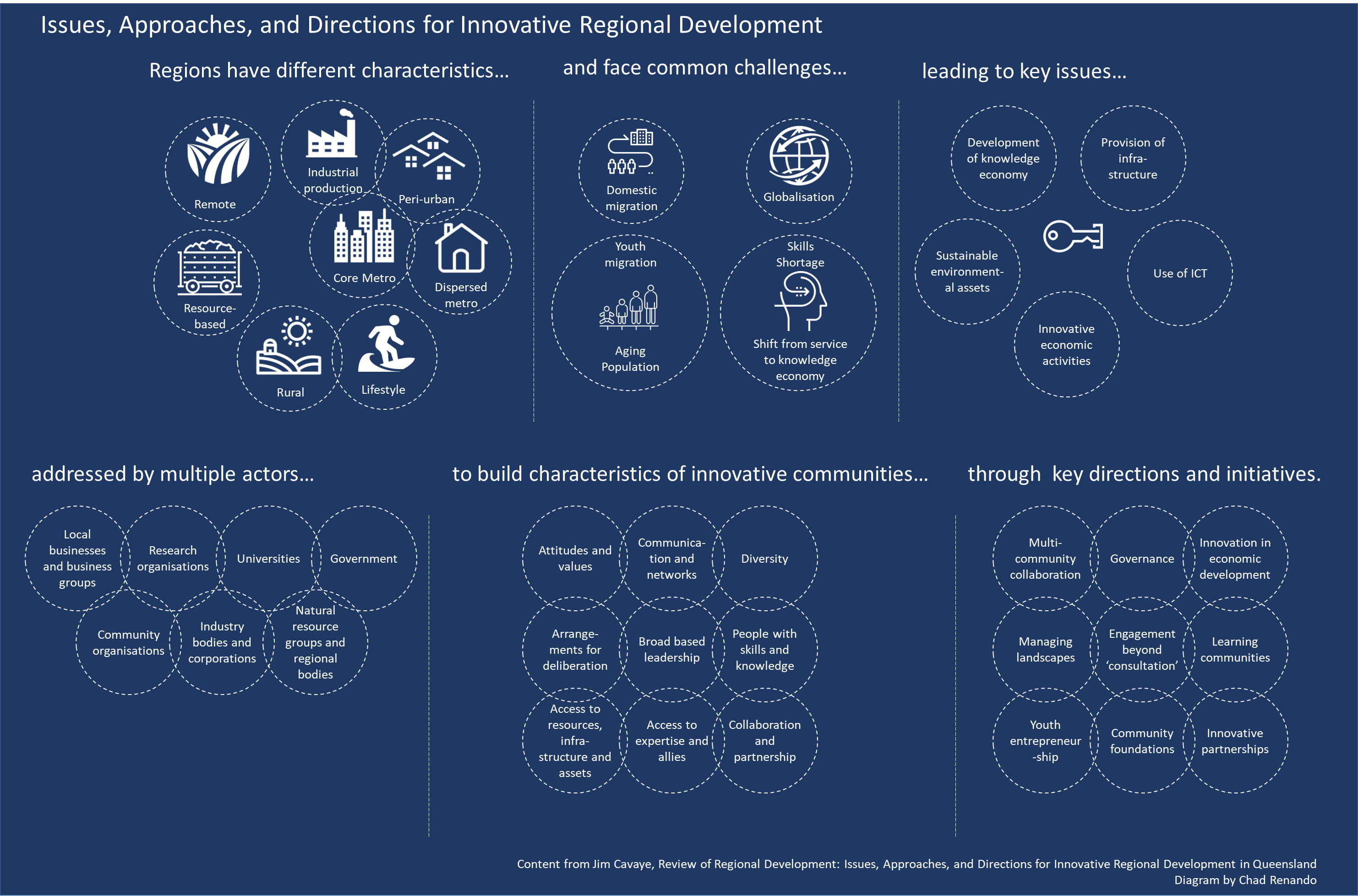“In a vibrant regional nation, regions would be engaged in the shift towards a knowledge-based economy, innovative models of service delivery would overcome some of the inherent inefficiencies and diseconomies in rural service provision, coordination between levels of government would support integrated governance, and natural resources would be managed as sustainable economic and environmental assets.”
With this opening, regional development thought leader Jim Cavaye provided a comprehensive outline in his Centre for Rural and Regional Innovation report Review of Regional Development: Issues, Approaches and Directions for Innovative Regional Development in Queensland.
I came across Cavaye’s article as I continue to explore who plays what role in developing innovation capability in regions, how those roles change based on the region, and where is it being done well in Australia and globally so lessons can be shared. I capture a summary and some thoughts here as a point of reference for myself and in the event it helps others doing great work in place-based innovation.
Types of regions
To start with, there is no one size fits all solution. Often the narrative of “regional development” seems to come from a perspective of addressing “the regions” as if it is a black and white argument of metro versus region. Not all regions are the same.
Cavaye refers to eight categories of “regions”, including:
- Core metropolitan regions
- Dispersed metro regions – suburban areas outside the central areas of major cities.
- Peri-urban regions – the fringe of urban centres mainly based on rural residential development and small lifestyle holdings.
- Industrial production regions – concentrated areas of manufacturing and industrial development.
- Lifestyle regions – areas with coastal, climate, scenic or cultural assets attractive to tourists, retirees and lifestyle-related industries.
- Rural regions – agricultural areas for farming and non-extensive grazing.
- Remote regions – extensive sparsely populated areas characterised by extensive pastoralism.
- Resource based regions – mining regions
Even regions with similar characteristics above will have different histories and culture. Communities can be impacted by the presence, or loss, of a major company or entrepreneurial leader. One community may have embedded leadership attached to traditional infrastructure investment, while another community may feel a strong need to diversify investment opportunities. A narrative of the success of a local entrepreneur can inspire one community while corruption within a local government can set another community back through risk-averse and business-as-usual behaviour.
Regional challenges
Some challenges are specific to the type of region, such as agriculture profitability and sustainability, demographic shifts in lifestyle regions from sea- or tree- changers, and supporting rapid growth of peri-urban regions. Other challenges are shared across regions:
- youth migration,
- aging populations,
- shifts from service to knowledge economies,
- globalisation, and
- skills shortages.
These challenges contribute to common key sets of issues:
- Infrastructure – not only physical and social infrastructure, but also attitudinal and intellectual “infrastructure” that helps regional people manage change and foster innovation;
- Economic base – developing and diversifying the economic base of communities and having new economic options;
- Assets – protection and enhancement of assets: economic, social, human, environmental and cultural assets;
- Leadership – Developing the capacity for planning and decision-making, including coordination and governance; and
- Support – Ensuring that communities have support and services.
Actors
These issues are the responsibility of a range of actors who all have the potential to contribute and at times actively inhibit innovation capability. The diversity and complexity of the challenges mean that no single organisation can address the challenges. Those involved include:
- All three levels of government;
- Community organisations;
- Universities
- Research organisations
- R&D entities
- Industry bodies and corporations
- Local businesses and business groups
- Natural resource groups and regional bodies
Who leads innovation in a region is an important question. A common position is that innovation should always have a focus on the entrepreneur. An ideal way to achieve this is for initiatives to be founder led.
However, without a seed entrepreneur or group of entrepreneurs, a sentiment I often hear is “if not us, then who?” Government and community groups invest in creating a more conducive environment for entrepreneurs. Local universities and education providers provide programs to build local entrepreneurial awareness and capability through practical programs. Natural resource groups provide programs to tap into and expand existing entrepreneurial mindsets.
Characteristics of innovative communities
The efforts of these organisations go beyond transactional programs. The end goal is not just “innovation”, but characteristics of innovative communities.
Cavaye pulled together a summary of research outlining these characteristics, with emerging themes including:
- Attitudes and values – a culture of experimentation and creativity,
- Communication and networks – ease of sharing information and ideas and having strong networks to deliberate and support action,
- Diversity – having a range of perspectives and embracing the creativity that can come from interaction between diverse sectors of the community,
- Functional organisations and arrangements for deliberation – having broad-based governance arrangements and open participative opportunities for community deliberation,
- Broad based leadership – effective shared leadership and the ability to managing local politics,
- People with skills and knowledge – including strong interpersonal and informal skills,
- Access to resources, infrastructure and assets – ways of redefining local assets and accessing appropriate resources,
- Access to expertise and allies – developing relationships with key informed people within and outside the community, and
- Collaboration and partnership – developing cooperation within the community and with outside “allies”.
These are the goals of entrepreneurial activity in the regions. Measurement of a region’s ability to achieve these goals is one of my focus areas. Measurement is often limited to transactional program and participant activity, with outcomes focused on lag metrics of jobs and investment. There is a growing body of work to measure the underlying entrepreneurial capability and capacity in a region, and a need to get this measurement more real-time.
What needs to happen
These challenges and opportunities have been known for some time, and Cavaye identifies a few key directions for communities. While he describes these in detail, I will bullet point them out in this post to be succinct:
- Multi-community collaboration
- Governance
- Innovation in economic development (Comprehensive economic development approach, Community-owned enterprise, Business incubators, Business clustering, Superannuation funds)
- Managing landscapes
- Engagement beyond “consultation”
- Learning communities
- Youth entrepreneurship
- Community foundations
- Innovative partnerships
There is no silver bullet initiative. There is little value in establishing a business incubator that is not aligned with a comprehensive economic development approach. Multi-community collaborations will fall apart without established, flexible governance. Youth entrepreneurship will generate little more than hype without innovative partnerships and connection with local business clusters.
Pulling it all together
I write this post for a few reasons.
First, it provides a point of reference and framework. As I look at the incredible working being done in regions across Australia, a framework of context, challenges, characteristics, and potential directions can help to identify gaps and opportunities. How are youth programs and business incubators different between predominantly lifestyle and industrial corridor communities? How are governance structures and innovation partnerships different based on who is involved? Are local youth programs addressing challenges of youth migration and skills shortage, and are they building community characteristics of access to external expertise and diversity?
Second is to demonstrate the complexity of doing work in regional innovation. There can be a sense of a simplistic solution for what is a complex challenge spanning both economic and community development. Are there instances of a community building a business incubator without broad collaboration, or an emphasis on programs over support for existing learning communities or innovative partnerships?
Third is to see the framework through the lens of the role of the innovation hub, which is the focus of my research. I am examining the role of the hub on community resilience, and the outline above provides a good checklist for research. Specifically:
- How are hubs different based on location in different region characteristics?
- How do hubs align with key issues of physical and cultural infrastructure, diversifying the economic base, protection of assets, developing leadership capacity and capability, and aligning with existing and providing new support services?
- Which actors are involved in the hub?
- How do hubs build characteristics of innovative communities, including: Attitudes and values; Communication and networks; Diversity; Functional organisations and arrangements for deliberation; Broad based leadership; People with skills and knowledge; Access to resources; infrastructure and assets; Access to expertise and allies; and Collaboration and partnership?
- Which key directions can the hub support or initiate?
These are some of the questions I am asking in my research of regional communities across Australia and as I review plans and strategies for local place-based initiatives including spaces and programs.
Finally, I write posts like this to find other like-minded people passionate about regional innovation. A sample of names and references for place-based regional innovation include:
- Department of Communities Community Capacity Building Toolkit for Ruiral and Regional Communities
- Understanding Community Development (Cavaye, 2015)
- Regional Incubator Support Program’s Regional Incubator Facilitators: Andrew Outhwaite, Brad Twynham, Daniel Smith, and Mark Phillips.
- Dianna Somerville, founder of Regional Innovation and Small Business Conference 8point8 and CEO of the Australia Post Regional Pitchfest
- Troy Hains, founder Innovation Ecosystems and theSPACE
- Kerry Anderson, founder Operation Next Gen
- Rural Business Collective, including leaders Fleur Anderson and Julia Telford
This list is far from exclusive. Feedback on this post is welcome, and please reach out or turn in great leaders in the comments below to share about others who are doing great work in place-based regional innovation activity.


